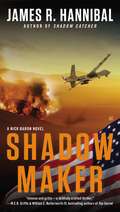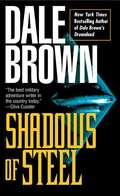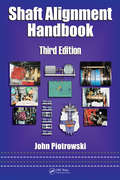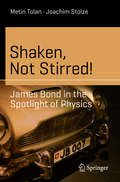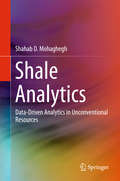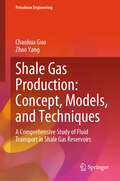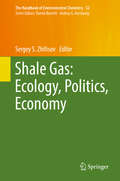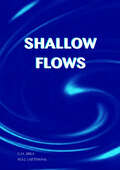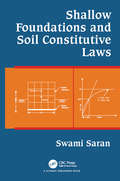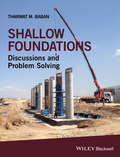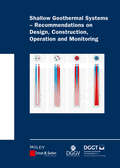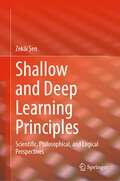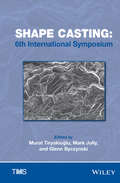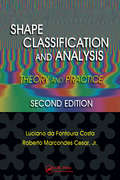- Table View
- List View
Shadow Maker
by James R. HannibalHow far will collateral damage from a CIA drone strike reach? When a suicide bomber shatters the peace of a winter afternoon on the National Mall in Washington, D.C., former pilot and undercover Cerberus operative Nick Baron receives an eerie invitation from the chess app on his phone--a mysterious figure named The Emissary wants to play. Nick and his covert unit--the Triple Seven Chase team--soon find themselves drawn into battle against an unknown opponent who has resurrected an ancient order of assassins: the legendary Hashashin. And there is a long-awaited prophecy being fulfilled by a series of violent attacks which may culminate in a final apocalypse over Jerusalem. As the Triple Seven fight to stop each attack, Nick tries to keep The Emissary on the hook by playing their digital chess game. The lines between the game and the fight begin to blur, as every time Nick loses a piece on the board, he loses one of his men. And if Nick cannot find a way to stop the terrorist mastermind, a checkmate may kill millions...
Shadow State: The gripping new novel from the original SAS hero
by Andy McNabIn the dark world of cryptocurrency, there's a high price to pay...From the central bank of El Salvador to a tantalum mine in Rwanda, the Acropolis Museum in Athens to the biggest freeport on the planet in Dubai, enter a world ruled by ones and zeroes and inhabited by people who don't believe in trust.Nathan Pike is one of those people. To some he's a digital Robin Hood. To others he's nothing but an amoral hacker. A codebreaking and encryption expert, he sells his skills to whoever can pay him what he wants or give him something he needs.And when he's sprung from a Cambodian prison by a woman calling herself Melody Jones, he's made an offer the likes of which he's never seen before.MORE PRAISE FOR ANDY MCNAB:'A tremendous adventure story' – Daily Telegraph'Extraordinary' – The Times'A rollercoaster ride' – Guardian'Full on, fast-paced, gripping' – Sunday Sport'Authentic to the core' – Daily Express'Stunning' – Sun'Unstoppable' – Daily Mirror
Shadow State: The gripping new novel from the original SAS hero
by Andy McNabIn the dark world of cryptocurrency, there's a high price to pay...From the central bank of El Salvador to a tantalum mine in Rwanda, the Acropolis Museum in Athens to the biggest freeport on the planet in Dubai, enter a world ruled by ones and zeroes and inhabited by people who don't believe in trust.Nathan Pike is one of those people. To some he's a digital Robin Hood. To others he's nothing but an amoral hacker. A codebreaking and encryption expert, he sells his skills to whoever can pay him what he wants or give him something he needs.And when he's sprung from a Cambodian prison by a woman calling herself Melody Jones, he's made an offer the likes of which he's never seen before.MORE PRAISE FOR ANDY MCNAB:'A tremendous adventure story' – Daily Telegraph'Extraordinary' – The Times'A rollercoaster ride' – Guardian'Full on, fast-paced, gripping' – Sunday Sport'Authentic to the core' – Daily Express'Stunning' – Sun'Unstoppable' – Daily Mirror
Shadow State: The gripping new novel from the original SAS hero
by Andy McNab'Terrific' Sunday Times ___________In the dark world of cryptocurrency, there's a high price to pay . . .From the central bank of El Salvador to a tantalum mine in Rwanda, the Acropolis Museum in Athens to the biggest freeport on the planet in Dubai, enter a world ruled by ones and zeroes and inhabited by people who don't believe in trust.Nathan Pike is one of those people. To some he's a digital Robin Hood. To others he's nothing but an amoral hacker. A codebreaking and encryption expert, he sells his skills to whoever can pay him what he wants or give him something he needs.And when he's sprung from a Cambodian prison by a woman calling herself Melody Jones, he's made an offer the likes of which he's never seen before.MORE PRAISE FOR ANDY MCNAB:'A tremendous adventure story' – Daily Telegraph 'Extraordinary' – The Times 'A rollercoaster ride' – Guardian 'Full on, fast-paced, gripping' – Sunday Sport 'Authentic to the core' – Daily Express 'Stunning' – Sun 'Unstoppable' – Daily Mirror
Shadow of a Hero
by Peter DickinsonTo save a country, a girl and her grandfather must learn what it means to be a hero The greatest hero in the history of Varina was baptized in a cave. Every schoolchild knows the story. His parents were on their way to the city when a storm drove them to take shelter in the mountainside, along with a priest, a bandit, and a scholar. When the storm did not abate, they asked the priest to give their child a name, and he christened the boy Restaur Vax. The boy would grow to be a warrior, a scholar, and a man of god, and his name would lead an oppressed people to independence for the first time. Alas, that liberty would not survive. Generations later, Vax's oldest living descendant is in London, teaching the language of Varina to his inquisitive young granddaughter. When his homeland is torn apart once more by war, calls come for this man to take up the mantle of the Vax name--and become a hero for a new age. This ebook features an illustrated personal history of Peter Dickinson including rare images from the author's collection.
Shadow of a Hero
by Peter DickinsonTo save a country, a girl and her grandfather must learn what it means to be a hero The greatest hero in the history of Varina was baptized in a cave. Every schoolchild knows the story. His parents were on their way to the city when a storm drove them to take shelter in the mountainside, along with a priest, a bandit, and a scholar. When the storm did not abate, they asked the priest to give their child a name, and he christened the boy Restaur Vax. The boy would grow to be a warrior, a scholar, and a man of god, and his name would lead an oppressed people to independence for the first time. Alas, that liberty would not survive. Generations later, Vax's oldest living descendant is in London, teaching the language of Varina to his inquisitive young granddaughter. When his homeland is torn apart once more by war, calls come for this man to take up the mantle of the Vax name--and become a hero for a new age. This ebook features an illustrated personal history of Peter Dickinson including rare images from the author's collection.
Shadowed (The Black Hat Thrillers #2)
by Karen E. OlsonAn ex-cyberthief is on the run from her past in an &“electrifying&” thriller by the author of Hidden: &“an addictive page-turner with a stunner of a finale&” (Kirkus Reviews). For fifteen years, her name was Nicole Jones. Then her criminal past caught up to her. Now the brilliant computer hacker has reinvented herself once again, living as Susan McQueen on a remote island in Quebec, Canada. Susan lives a quiet life, but she hasn&’t given up her computer. While in an online chatroom, she discovers she has a shadow. Someone&’s hacked into her laptop—someone who knows who she is. Capable of watching her every move, they want a hefty payment in bitcoin not to make trouble. Now Susan is on the run again. But from whom? Is it the FBI or someone associated with her criminal past? Making her way across the border and back to America won&’t be easy. And as her shadow looms closer, Susan discovers just who—and what—she&’s up against.
Shadows of Steel (Patrick McLanahan Series #5)
by Dale BrownDeath, destruction, and military initials once again fill the air as Dale Brown brings together the surviving members of the crew from his Flight of the Old Dog for his latest adventure. Another Gulf War has begun, this time with Iran, a U.S. vessel has been sunk in the Persian Gulf, America's might has been (once again) crippled by short-sighted military budget cuts, and the only hope is a surgical strike by a secret weapon called Future Flight. Since our old pal Col. Patrick McLanahan of the Old Dog is in charge, how can it miss? As Brown points out, this story takes place in time between his Day of the Cheetah and Hammerheads.
Shady Practices: Agroforestry and Gender Politics in the Gambia
by Richard A. SchroederShady Practices is a revealing analysis of the gendered political ecology brought about by conflicting local interests and changing developmental initiatives in a West African village.
Shaft Alignment Handbook (Mechanical Engineering)
by John PiotrowskiRotating machinery is the heart of many industrial operations, but many engineers and technicians perform shaft alignment by guesswork or with limited knowledge of the tools and methods available to accurately and effectively align their machinery. Two decades ago, John Piotrowski conferred upon the field an unprecedented tool: the first edition of
Shaken, Not Stirred!: James Bond in the Spotlight of Physics (Science and Fiction)
by Joachim Stolze Metin TolanHow do James Bond’s X-ray glasses work, the ones he uses to see whether the lady at the roulette table has a pistol concealed in her underwear? Is it really possible to launch oneself into the air and catch up with a plane that is free-falling towards the earth? Or to shoot down a helicopter with a pistol? In this lively and informative book, Germany's boldest physics professor Metin Tolan analyses the stunts and gadgets of the 007 films and even answers the question of all questions: Why does Bond drink his vodka martini shaken, not stirred? "So much entertaining science is a rare thing." Spiegel Online
Shaking the Foundations of Geo-engineering Education
by Bryan McCabe Marina Pantazidou Declan PhillipsThis book comprises the proceedings of the international conference Shaking the Foundations of Geo-engineering Education (NUI Galway, Ireland, 4-6 July 2012), a major initiative of the International Society of Soil Mechanics and Geotechnical Engineering (ISSMGE) Technical Committee (TC306) on Geo-engineering Education. SFGE 2012 has been carefully
Shale Analytics
by Shahab D. MohagheghThis book describes the application of modern information technology to reservoir modeling and well management in shale. While covering Shale Analytics, it focuses on reservoir modeling and production management of shale plays, since conventional reservoir and production modeling techniques do not perform well in this environment. Topics covered include tools for analysis, predictive modeling and optimization of production from shale in the presence of massive multi-cluster, multi-stage hydraulic fractures. Given the fact that the physics of storage and fluid flow in shale are not well-understood and well-defined, Shale Analytics avoids making simplifying assumptions and concentrates on facts (Hard Data - Field Measurements) to reach conclusions. Also discussed are important insights into understanding completion practices and re-frac candidate selection and design. The flexibility and power of the technique is demonstrated in numerous real-world situations.
Shale Gas Production: A Comprehensive Study of Fluid Transport in Shale Gas Reservoirs (Petroleum Engineering)
by Zhao Yang Chaohua GuoThis book is a comprehensive overview of shale gas science and engineering, covering key facets such as the geological and geochemical characteristics of shale gas reservoirs, gas transport mechanisms in shale nanopores, mathematical models and case studies for gas production, and enhancing gas recovery methods. The author presents a systematic summarization of gas flow and production in shale gas reservoirs from micropore to macro-reservoir scale. The research methods encompass experiments, well-testing, numerical simulation, and mathematical derivation. Designed primarily as a reference work for petroleum industry practitioners and researchers, this book is equally valuable for new entrants and seasoned professionals. It is also an excellent resource for undergraduate and postgraduate courses and of interest to libraries at universities offering gas, oil, and general energy courses. Whether you're seeking an introduction to the field or a detailed exploration of advanced concepts, this book provides a valuable and complete guide to shale gas science and engineering.
Shale Gas: Ecology, Politics, Economy
by Sergey S. ZhiltsovThis book highlights various aspects of shale gas production and discusses the associated problems, which have greatly influenced the current situation on the global gas market. It focuses on issues such as production technologies, environmental protection, and the impacts of shale gas production on human beings. Further, it investigates the role of shale gas in the development and implementation of foreign policy of many nations that welcomed the possibility to produce this hydrocarbon in their own countries. Taking into consideration the information published by world energy research centers, the prospects of shale gas production in different regions of the world are examined in detail. Given its coverage and scope, the book will greatly benefit specialists in the areas of hydrocarbon production, international relations and foreign policy, world economics and technologies, ecology and environmental protection.
Shallow Flows: Research Presented at the International Symposium on Shallow Flows, Delft, Netherlands, 2003
by Gerhard H. Jirka Wim S.J. UijttewaalThis text presents the key findings of the International Symposium held in Delft in 2003, which explored the process of shallow flows. Shallow flows are found in lowland rivers, lakes, estuaries, bays, coastal areas and in density-stratified atmospheres, and may be observed in puddles, as in oceans. They impact on the life and work of a wide variety of readers, who are here provided with a clear overview of the subject. Shallow flows are intrinsically turbulent. On one hand, there are strongly three-dimensional, small-scale turbulent motions and on the other hand, large-scale quasi-two-dimensional turbulence. This book explains and examines these differences and their effects with sections on transport processes in shallow flows; shallow jets, wakes and mixing layers; stratified and rotating flows in ocean and atmosphere; river and channel flows; and numerical modelling and turbulence closure techniques. The reader is provided with the pick of current studies and a fresh approach to the subject, with expert examination of a fascinating and crucial phenomenon of our world's water systems.
Shallow Foundations and Soil Constitutive Laws
by Swami SaranThe book offers a systematic analysis of footings (i.e. shallow foundations) in a realistic way, using constitutive relationships of the soil. The aim of the book is to deal with the theme holistically, involving the determination of the constitutive law of the soil, and then proportioning the footing occurring in different situations in actual practice. The book has eleven chapters. After giving an introduction and scope of the book in the first chapter, second and third chapters are respectively devoted to constitutive laws of soil and basic stress equations. In the third chapter analysis of strip footings subjected to central vertical load has been dealt. This analysis has been extended for eccentric –inclined load in the fifth chapter. Since problems of shallow foundations resting adjacent to a slope are of prime importance, this aspect has been dealt in sixth chapter. In the seventh chapter, analysis pertaining to square and rectangular footings have been presented. Effect of interference between adjacent footing is covered in chapter eight. Since ring footings are usually provided for tanks, silos, towers etc., ninth chapter is devoted to this. Added attraction of the book is its chapter ten in which footings located in seismic regions have been covered. Effect of embedment below the ground surface on the behavior of footings located both in non-seismic and seismic regions has been dealt in the chapter eleven. The book is intended for senior undergraduate, postgraduate and Ph.D. students of civil engineering, research scholars, practicing engineers, teachers and academicians. The analyses are based on the latest information available. A number of illustrated examples have been included in the text. SI units have been used in the book.
Shallow Foundations: Bearing Capacity and Settlement, Third Edition
by Braja M. DasFollowing the popularity of the previous edition, Shallow Foundations: Bearing Capacity and Settlement, Third Edition, covers all the latest developments and approaches to shallow foundation engineering. In response to the high demand, it provides updated data and revised theories on the ultimate and allowable bearing capacities of shallow foundations. Additionally, it features the most recent developments regarding eccentric and inclined loading, the use of stone columns, settlement computations, and more. Example cases have been provided throughout each chapter to illustrate the theories presented.
Shallow Foundations: Discussions and Problem Solving
by Tharwat M. BabanShallow Foundations: Discussions and Problem Solving is written for civil engineers and all civil engineering students taking courses in soil mechanics and geotechnical engineering. It covers the analysis, design and application of shallow foundations, with a primary focus on the interface between the structural elements and underlying soil. Topics such as site investigation, foundation contact pressure and settlement, vertical stresses in soils due to foundation loads, settlements, and bearing capacity are all fully covered, and a chapter is devoted to the structural design of different types of shallow foundations. It provides essential data for the design of shallow foundations under normal circumstances, considering both the American (ACI) and the European (EN) Standard Building Code Requirements, with each chapter being a concise discussion of critical and practical aspects. Applications are highlighted through solving a relatively large number of realistic problems. A total of 180 problems, all with full solutions, consolidate understanding of the fundamental principles and illustrate the design and application of shallow foundations.
Shallow Geothermal Systems: Recommendations on Design, Construction, Operation and Monitoring
by Deutsche Gesellschaft für Geotechnik Deutsche Gesellschaft für GeowissenThe recommendations summarise the state of the art. Their aim is the proper exploitation of the ground for geothermal purposes without adversely affecting the ground or the groundwater on the one hand and the operation of the system and nearby buildings on the other. The recommendations should be used during consulting, design, installation and operation in order to achieve optimum and sustainable use of the ground at a specific location. Authorities responsible for supervising and approving projects can use the recommendations as a guide when taking decisions and making stipulations. The Geothermal Energy Study Group was set up in Bochum in 2004 and became the joint DGGV/DGGT study group in 2007. Some 20 specialists from universities, authorities and engineering consultants are active in the group and meet two or three times a year.
Shallow and Deep Learning Principles: Scientific, Philosophical, and Logical Perspectives
by Zekâi ŞenThis book discusses Artificial Neural Networks (ANN) and their ability to predict outcomes using deep and shallow learning principles. The author first describes ANN implementation, consisting of at least three layers that must be established together with cells, one of which is input, the other is output, and the third is a hidden (intermediate) layer. For this, the author states, it is necessary to develop an architecture that will not model mathematical rules but only the action and response variables that control the event and the reactions that may occur within it. The book explains the reasons and necessity of each ANN model, considering the similarity to the previous methods and the philosophical - logical rules.
Shape Casting
by Tms Murat Tiryakioǧlu Mark Jolly Glenn ByczynskiThis collection presents papers on the science, engineering, and technology of shape castings, with contributions from researchers worldwide. Among the topics that are addressed are structure-property-performance relationships, modeling of casting processes, and the effect of casting defects on the mechanical properties of cast alloys.
Shape Casting: 7th International Symposium Celebrating Prof. John Campbell's 80th Birthday (The Minerals, Metals & Materials Series)
by Mark Jolly William Griffiths Murat TiryakioğluThis book contains a collection of papers on the science, engineering, and technology of shape casting, with contributions from researchers worldwide. Among the topics that are addressed are the structure-property-performance relationships, modeling of casting processes, and the effect of casting defects on the mechanical properties of cast alloys.
Shape Classification and Analysis: Theory and Practice, Second Edition (Image Processing Series)
by Luciano da Costa Roberto Marcond Cesar, Jr.Because the properties of objects are largely determined by their geometric features, shape analysis and classification are essential to almost every applied scientific and technological area. A detailed understanding of the geometrical features of real-world entities (e.g., molecules, organs, materials and components) can provide important clues about their origin and function. When properly and carefully applied, shape analysis offers an exceedingly rich potential to yield useful applications in diverse areas ranging from material sciences to biology and neuroscience.Get Access to the Authors’ Own Cutting-Edge Open-Source Software Projects—and Then Actually Contribute to Them Yourself! The authors of Shape Analysis and Classification: Theory and Practice, Second Edition have improved the bestselling first edition by updating the tremendous progress in the field. This exceptionally accessible book presents the most advanced imaging techniques used for analyzing general biological shapes, such as those of cells, tissues, organs, and organisms. It implements numerous corrections and improvements—many of which were suggested by readers of the first edition—to optimize understanding and create what can truly be called an interactive learning experience. New Material in This Second Edition Addresses Graph and complex networks Dimensionality reduction Structural pattern recognition Shape representation using graphs Graphically reformulated, this edition updates equations, figures, and references, as well as slides that will be useful in related courses and general discussion. Like the popular first edition, this text is applicable to many fields and certain to become a favored addition to any library. Visit http://www.vision.ime.usp.br/~cesar/shape/ for Useful Software, Databases, and Videos
Shape Memory Alloy Actuators
by Mohammad ElahiniaThis book provides a systematic approach to realizing NiTi shape memory alloy actuation, and is aimed at science and engineering students who would like to develop a better understanding of the behaviors of SMAs, and learn to design, simulate, control, and fabricate these actuators in a systematic approach. Several innovative biomedical applications of SMAs are discussed. These include orthopedic, rehabilitation, assistive, cardiovascular, and surgery devices and tools. To this end unique actuation mechanisms are discussed. These include antagonistic bi-stable shape memory-superelastic actuation, shape memory spring actuation, and multi axial tension-torsion actuation. These actuation mechanisms open new possibilities for creating adaptive structures and biomedical devices by using SMAs.
